Abstract
Sustainability and resilience are major challenges for the building sector in order to meet energy efficiency and low carbon emissions goals. Based on the defined and quantified targets of the EU climate change policy, Renewable Energy Systems (RESs) are among the top-priority measures for accomplishing the target of decarbonization in buildings. Nevertheless, the choice of the type of RES is not a one-dimensional problem, and the optimal combination may not be unique. The aim of this paper is the energy and environmental evaluation of renewable energy technologies with emphasis on biomass and solar thermal systems for heating applications in residential buildings. More specifically, and aiming at the maximum possible contribution of renewable energy sources in the total final energy consumption for the needs of zero energy buildings, different scenarios are presented based on a Life Cycle Energy Analysis (LCEA) approach. The methodology is based on quantifying the environmental impacts (midpoint analysis), as well as endpoint analysis, in order to define the impact on human health, ecosystem damage, and resource depletion. The LCEA has been conducted, supported by the SimaPro tool, ensuring the environmental impact assessment result. A combination of RES technologies based on solar and biomass are examined and compared to conventional fossil fuel heating systems according to technical, energy, and environmental criteria. Finally, the energy system technologies were compared in correlation to a building’s thermal insulation level. The first set of simulations fulfilled the minimum thermal insulation requirements, according to the national energy performance regulation, whilst the second set of simulations was based on increased levels of insulation. The point of this analysis was to correlate the impact of thermal insulation to RES technologies’ contribution. The results determined that the best available energy solution, focusing on technical and environmental criteria, is the combination of biomass and solar thermal systems for covering the heating processes in residential buildings. More specifically, the combined biomass–solar system has a lower overall environmental impact, due to the reduction in gaseous pollutant emissions, as well as the reduction in the amount of used fuel. The reduction in the total environmental impact amounts to a percentage of approximately 43%.
1. Introduction: Focusing on Energy and Climate Change Policy Targets
Taken as a fact the EU efforts from 2000 till now in the scientific field of the energy and environment it is more than evident that Renewable Energy Systems as well as carbon emissions indicators will remain key issue targets for the 2030 as well as 2050 policy [1,2]. More specific, it is well known that by 2050 the expected rate of reduction will come up to 80–95% compared to 1990 levels reaching the ambitious goal of carbon neutrality [3].
In order to accomplish the significant reduction of carbon emissions up to more than 80% the only way is to increase the share of Renewable Energy Systems implementation in the energy sector. As can be observed in Figure 1 since 1990, greenhouse gas emissions in the EU have been constantly reduced while the share of renewables has increased (Figure 2) [4]. This trend continued in recent years, with emission reductions in the EU-28 falling to 23% below 1990 levels in 2018 and 26% in 2019 (24% in the EU-27 only in 2019) [5].
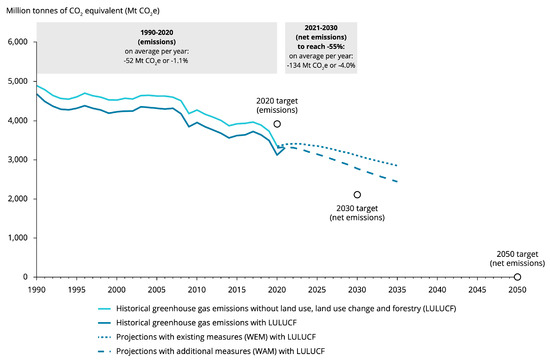
Figure 1.
EU progress toward 2030 targets on environment [5].
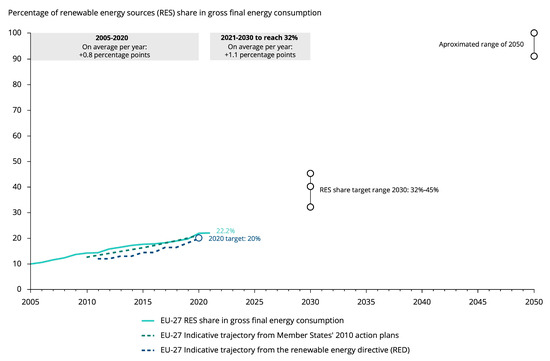
Figure 2.
EU progress toward 2030 targets on RES integration [5].
Overall, by the end of 2020, the EU-27’s 2020 GHG emissions were 32% below 1990 levels, thus far exceeding the 2020 target of a 20% reduction. Similarly, the reduction in final and primary energy consumption also exceeded 20% targets, albeit mainly due to the impact of COVID-19, which led to a sharp decrease for the year in 2020. Considering renewable energy generation, a level of 22.2% was achieved, therefore also meeting the target, as it can be seen in Figure 2. One point of interest is that, while the shares of electricity, heating, and cooling provided by renewables helped meet the overall EU target, underperformance in the growth of RES used in the transportation sector continued.
A second point of interest is that, as the final 2020 figures demonstrate, most EU-27 countries achieved their national energy and climate targets, as it can be observed in Figure 3. However, in order to remain on track towards the 2030 and 2050 targets, supplementary and targeted measures are needed from each member state.

Figure 3.
EU member states’ progress toward 2030 targets on RES integration [5].
Having a closer look at the environment, the Intergovernmental Panel on Climate Change (IPCC) records, in its report on climate change in 2021, an increase in the average temperature on the Earth’s surface equal to approximately 1.3 °C [6]. Based on the predicted climate changes, it becomes clear that the effects of the climate change phenomenon are expected to be particularly harmful for all sectors that contribute to sustainable development. Furthermore, it is worth noting that the increase in extreme weather phenomena related to the earth’s temperature increase causes a significant increase in costs for building maintenance and infrastructure projects in general. According to UNECE, the total cost of road and rail rehabilitation exceeds EUR 22 billion [7].
At this point, it becomes essential to associate the current global climate change with the greenhouse effect. The term greenhouse effect describes the increase in average global temperature due to the increased concentration of greenhouse gases in the atmosphere. In more detail, according to NOAA measurements from the Mauna Loa Observatory, the concentration of CO2 was 415.95 ppm in September 2022, the highest value in recent years, while the trend is increasing. The same trend is observed for the other greenhouse gases.
The proposals of the scientific community, regarding the climate crisis, are based on the reduction in GHG emissions. Based on statistical data from Eurostat, it is clear that, regarding greenhouse gas emissions, the most aggravating sectors in the European Union are the building sector and, more specifically, the use of fossil fuels for heating and domestic hot water applications, as well as the transportation sector based on Table 1 [8]. Thus, it becomes obvious, once again, that the replacement of fossil fuels with renewable energy technologies, such as biomass or solar thermal systems, is mandatory.

Table 1.
Carbon emissions and share of total by sector (reference year 2020) [8].
According to statistical data [Table 1], and focusing on Europe, it is worth mentioning that the building sector significantly affects the carbon indicator, with a total share of 21%. Additionally, as it is a sector strongly related to the health and well-being of citizens, it is a key issue sector for the vision of carbon neutrality. Apart from the environmental point of view and the sustainability parameter of cities, one should not forget the financial effectiveness of the proposed actions, as well as the social impact to citizens.
Based on this analysis regarding energy and climate change, it is more than obvious that Renewable Energy System contribution is important in order to achieve the energy efficiency and carbon neutrality goals. The building sector seems to incorporate a greater percentage of RESs, and this is even more the case for residential buildings. More specifically, RESs are integrated in the building sector (residential and services) by 35%, while in the transportation sector only by 5%.
This is by no means circumstantial. From 2002 to the present, a number of European Directives have been issued to achieve these targets. All directives have been harmonized in the legislation of each EU Member State, through national laws, taking into account the particular climate, economic, and social conditions prevailing in each country. Focusing on the energy performance of buildings and the series of consecutive directives which have been issued in the past to boost the energy and environmental performance of buildings, it is interesting to discuss the long-term strategies and goals which are in total compliance with the energy and environmental policy of the EU. The short-term goal of 20-20-20 has by and large been reached, and we are in the process of meeting the medium-term milestones of 2030 and aiming for the long-term vision of climate neutrality by 2050. The digitalization and smart technology implementation (such as building automations, control systems and devices, smart metering, etc.) are the tools for meeting the challenges of carbon neutral, ZEB buildings. It must be added that, in March 2023, the European Parliament adopted its position on the latest Energy Performance of Buildings Directive recast, which is, among other things, setting the goal for Zero Carbon Buildings. Experience from the implementation of the directives so far has demonstrated that the integration of renewables in the building sector is a necessity in order to meet the goals of Zero Energy and Zero Emissions Building.
Τhe share of RESs across the EU for heating and cooling applications has increased by, on average, 0.7 percentage points per year for the period of 2005–2017, with approximately 19.5% ultimately coming from RESs. The most common renewable energy technologies used in heating and cooling applications are solid biomass, heat pumps, and solar thermal systems [8]. In this line of approach, this paper focuses on two thermal systems, namely: solid biomass and solar thermal ones. Starting with biomass, according to the European Directive 2009/28/EC, the term biomass refers to the biodegradable fraction of products, waste, and residues originating from the agricultural sector (plant and animal substances), the forestry sector, and similar industrial units, as well as the corresponding fraction of industrial and municipal waste. In general, the above definition includes all forms of organic matter, which come either directly or indirectly from the plant category [9]. Therefore, it becomes clear that other forms of matter, such as animal manure, straw, slaughterhouse waste, and organic food residues, fall within the definition and can be considered as sources of biomass [10].
Direct and diffuse solar radiation have been trusted and reliable for more than 50 years as technologies used for domestic hot water production, and for space heating, both in residential and commercial buildings, whilst the solar air conditioning option, although also known and available, remains rather too expensive to be used [11,12,13]. The analysis that follows is basically a combination of RES technologies based on solar and biomass compared to conventional fossil fuel heating systems, according to technical, energy, and environmental criteria. The methodology for evaluating the systems in terms of energy efficiency, as well as environmental impacts, is the Life Cycle Analysis (LCA).
Finally, it is important to emphasize the novelty and the highlights of the manuscript. As RESs are proven to be among the top priority tools towards energy efficiency and carbon neutrality, different scenarios are studied, more specifically:
- -
- Biomass technologies are examined in terms of residential applications with the minimum insulation required by the legislation.
- -
- Biomass technologies in cooperation with solar thermal systems in terms of residential applications with extra insulation.
The additional insulation is added as a scenario in order to examine if extra insulation has a positive or a negative impact on the energy system’s environmental behavior [14].
In the next paragraphs, the methodology for evaluating the environmental impacts is analyzed in detail. Moreover, the state-of-the-art analysis in biomass residential applications is highlighted, as well as the systems implemented for the case study that follows. Finally, the results analysis is presented for the different simulation scenarios.
It is also necessary to mention the novelty of the research carried out. Basically, there two important issues analyzed in the framework of the study: the first is the implementation of RES systems based on biomass technologies also in cooperation to solar thermal systems, which are widely implemented in residential buildings; the other issue is the correlation of the RES system to the insulation, which is a top priority measure regarding building energy upgrades. Finally, a large, detailed technical analysis of the systems evaluated was conducted in order to provide accurate information regarding the systems at the inventory stage of the Life Cycle Analysis implementation.
2. Review of Life Cycle Analysis Applications on Biomass Systems for Buildings
There are several applications of biomass boilers, the majority of them in combination with other RES technologies and more specific solar systems. Some of the case studies are presented in detail with regards to the type of analysis and the stages included in the LCA, the database used, and the main findings in relevance to the environmental impacts and benefit focused on climate change, which is a defined target of the EU policy. The different case studies regarding the biomass implementation evaluate the environmental impacts based mainly on the LCA methodology, and sometimes by using the cradle-to-grave approach (including raw material extraction, manufacturing process, transportation, use, and demolition stage) and in some other studies, mainly because of lack of primary input data, the cradle-to-gate approach is implemented (including extraction, manufacturing, storage, and transportation, and omitting use phase and demolition) [15,16,17,18].
Ghafghazi Saeed et al. [19] used LCA methodology to assess and compare the environmental load from covering the base load of a district heating plant in Vancouver for four different energy sources. More specifically, the use of natural gas, pellets, waste sludge, and geothermal energy was evaluated. The LCA included all stages of the life cycle, from the production of the fuel to the end use of the system. The IMPACT 2002+ methodology was used to assess the environmental impacts. The collection of the required data was based on bibliographic references and published databases originating from Canada. The main conclusion was that there is a reduction in carbon dioxide equivalent emissions by 200 kg CO2,eq for each MWh of thermal energy produced when renewable energy sources are used.
Monteleone Beatrice et al. [20] used the LCA methodology and, more specifically, the SimaPro software (version 8.1), in order to calculate the environmental impact caused by the use of boilers with different fuel each time. In more detail, the study compared a 15 kW oil, natural gas and pellet boiler, while two new technology pellet boilers, BioWIN and BioWIN 2, with a power of 10 kW each, manufactured by the company Windhager Zentralheizung Technik GmbH, Wallersee, Austria, were also studied. The required input data were obtained from the manufacturers, from the literature references, as well as from the available software libraries. The environmental impact assessment was carried out using the Eco-Indicator 99 assessment method for all life cycle stages. From the research, it was demonstrated that biomass boilers presented a significantly lower environmental impact compared to the corresponding fossil fuel boilers.
Grygierek, Krzysztof and Ferdyn-Grygierek, Joanna [21] investigated the environmental impact of a residential building in Warsaw, with a building surface of 153 m2. In more detail, two different construction materials, two different external thermal insulation scenarios, as well as four different heating systems, including a biomass boiler, were evaluated. OneClick LCA software was used for the LCA. The input data in terms of energy consumption were obtained from simulation with Energy Plus™; version 9.4.0 software, while the remainder of the required data were either obtained from databases or the literature references. The LCA included the entire life cycle, from the extraction of the materials to the production of thermal energy. It was demonstrated that, for this specific application, out of the five categories of environmental impact investigated at the intermediate point level, the biomass boiler had the lowest environmental impact compared to the other systems.
Furthermore, Neri Esmeralda et al. [22] used the LCA approach, aiming at the environmental assessment of a 600 kW district heating plant in the Bologna area with raw material available from green waste residues of public and private green spaces. This plant was compared to a district heating unit using natural gas as raw material. The analysis was based on cradle-to-gate system limits. The required data for both the natural gas and the biomass plant case were obtained from national bodies such as INFC and GSE, from the literature references, as well as from the Ecoinvent 3.1 database. The environmental impact assessment was carried out using the ReCiPe 2008 method at the intermediate point level. The SimaPro simulation tool was used, and the results demonstrated a reduction of approximately 40% of the impact on the climate change phenomenon per MWh produced when the residual biomass was used. Finally, both contribution analysis and sensitivity analysis were performed, aiming to identify the most aggravating process. It was concluded that that the process with the greatest impact is the transfer of raw materials to the plant.
Jose Adolfo Lozano Miralles et al. [23] conducted LCA to calculate the environmental impacts of an air-to-air heat pump and a biomass boiler when they are used as the main heating systems in an administration building at the University of Jaen in Spain. The required data, regarding energy consumption, were calculated from the building’s operating profile, while the technical characteristics of the boilers, as well as the materials used, came from the manufacturers and the databases of the SimaPro software. The analysis included the whole life cycle of the systems, while the environmental impact assessment was done using the Eco-Indicator99 and EPS2000 methods. Authors concluded that, when the Eco-Indicator 99 method is used, the air-to-air heat pump has the greater environmental impact, while with the EPS2000 method, the results were exactly the opposite.
Elisa Moretti et al. [24] estimated the environmental impact of a commercial building with two different heating–cooling systems, by using the SimaPro simulation tool. The first system consisted of a 100 kW biomass boiler and a 45 kW absorption chiller, while the second one comprised a natural gas boiler for the heating demand and a heat pump (EER = 3.82) for the cooling loads. The energy consumption data were obtained from the previous year’s operation, while the data regarding the infrastructure were obtained from SimaPro databases. The environmental impact assessment was carried out using the ReCiPe 2008 method at both the intermediate and endpoint levels. It should be noted that the analysis was conducted for the construction stages of the infrastructure, production and transport of the fuel, and the operation of the unit. The results demonstrated that the biomass system presented 20% reduced environmental impact.
Košičan Jaroslav et al. [25], in their research, examined different solar thermal systems with a second heat source, in order to meet the energy demand of a residential building in Slovakia. More specifically, four different combinations of solar thermal collectors with natural gas, a biomass boiler, and a heat pump were examined. Firstly, by using the T*SOL program, the energy consumptions of the secondary heat source as well as the contribution of solar thermal collectors were calculated. Thereafter, using the OneClick LCA software, an LCA was performed for each system, in order to determine the contribution of each production stage to the total environmental footprint. The limits of the analysis extend from the production of raw materials and the operation, up to the final disposal, while six main environmental impact categories were studied. Finally, based on some cost data, a multicriteria analysis was carried out, in order to identify the most feasible solution.
Last but not least, Feofilovs Maksims, and his co-authors [26], studied the environmental impact of a low-temperature district heating plant. In particular, one scenario, with a biomass boiler in combination with photovoltaic panels to cover the electricity requirements, and another scenario without the photovoltaics were examined. System limits included plant construction and operation for a lifetime of 20 years. The heat generated per surface area was used as the operational unit, while Impact 2002+ was used as the environmental impact assessment methodology. It was concluded that the combination of biomass boiler and photovoltaic panels had the lower environmental impact. The overview of indicative LCA studies in relation to biomass systems applications are presented in Table 2.

Table 2.
Overview of indicative LCA studies on biomass applications.
In terms of systems’ environmental impact assessment evaluation, RES technologies also cooperate with ventilation systems, which ensure the health and well-being of users in relation to indoor air quality and thermal comfort [28]. Based on the literature analysis, the combination of biomass boilers with solar technologies demonstrated increased energy efficiency and reduced carbon emissions; therefore, this combination demonstrated a reduced impact to the climate change aspect. Nevertheless, the issue regarding air quality with the use of biomass remains to be answered as it affects human health. The endpoint analysis in the session that follows aims to quantify the biomass impact to human health. Another important issue regarding RES implementation is the part of new technology introduction, something that is also supported by the Green Deal, so based on biomass research, biofuels are proved to be a new upcoming, very promising technology in the energy field [29]. As mentioned above, this paper tries to combine different energy systems, in particular, solar-thermal, focusing on biomass applications for the urban environment, and mainly on buildings [30,31]. Of course, biomass systems, based also on Hou [32], can also be implemented in rural applications. Furthermore, in terms of RESs, another significant parameter is the integrated design of the systems based on the targets of policy [33], and taking into consideration other issues such as logistics, transportation, cooperation with other systems, and processes such as ventilation, which also affect the quality of living for users [33,34,35]. Finally, the strong correlation of buildings with the environment expressed by weather conditions is an interesting issue for research because of the impact of weather prediction to the estimation of thermal and cooling loads [36]. Thus, it is more than evident that the selection of energy systems is a polyparametric issue that needs integrated design and evaluation based on different criteria. For the environmental evaluation, the methodology of Life Cycle Analysis provides a comprehensive evaluation and is presented in the next paragraph in detail.
3. Life Cycle Analysis (LCA) and Life Cycle Energy Analysis (LCEA): Methodology Description
The methodology used for LCA is based on a protocol that has been structured following the provisions of the ILCD Handbook that followed the ISO 14040 series [37]. The ILCD guide was prepared by the Joint Research Centre (JRC) and is recommended by the European Commission to support the legitimacy of results of LCA studies, by ensuring consistency and quality assurance. According to the ILCD guide, the basic phases that must be included in a LCA study cover the definition of goal and scope, preparation of the data inventory, impact assessment, and interpretation of the results, as presented in Figure 4.
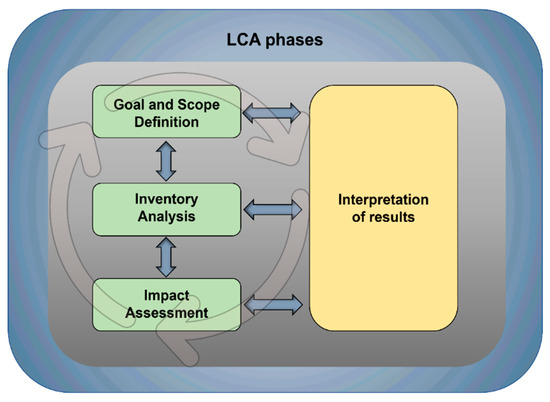
Figure 4.
Phases of the LCA methodology [29].
Life Cycle Assessment (LCA) is a structured, comprehensive, and internationally standardized method (certified by ISO 14040 and 14044 standards) for assessing the environmental, resource depletion, and health impacts associated with products or services. It quantifies all relevant emissions and resources consumed and the related impacts using a “from cradle to grave” approach, by taking into account a product’s full life cycle: from the extraction of resources, through production, use, and recycling, up to the disposal of remaining waste. In case there are not adequate input data regarding the operation phase and the end of use stage, the LCA analysis is limited to a “cradle to gate” approach, focusing mainly on raw material extraction, manufacture, and transportation before the use phase and the demolition stage. After defining the scope, the goal of the study, the reference unit, and the functional unit for the benchmarking of the results, the inventory analysis follows. At this stage of analysis, the initial data are gathered per process and stage of the system selected. The types of input data in the inventory analysis are raw materials, energy, and water. Based on the reliability of the input data selected, the quality of the impact assessment stage is affected [35]. The LCEA follows the same methodology, but the inventory analysis is focused on the energy flows. The resource analysis in the inventory phase is mainly that of the energy consumption (primary or final) per process. Additionally, in an LCEA approach, more emphasis is given to the operation stage.
Life Cycle Impact Assessment (LCIA) impact categories to be covered and the selection of specific LCIA methods (midpoint and/or endpoint level) to be applied, as well as—if included—normalization data and weighting set, in order to ensure that their selection is not conducted in an interest-driven view of the initial results and that relevant and matching inventory data are collected. All of the defined impact categories will be covered by the combination of selected LCIA methods. The environmental impacts include, but are not limited to, climate change, ozone depletion, photochemical ozone formation, respiratory inorganics, ionizing radiation, acidification, eutrophication, human toxicity, ecotoxicity, land use, and resource depletion [38].
It is evident that the LCA and LCEA are particularly complicated and time-consuming processes, mainly due to the large amount of primary data that must be collected. However, the majority of industrial units do not have a comprehensive database for all of the processes used, as well as for the distribution of energy consumption. Additionally, it should be noted that some parts of the infrastructure come from different manufacturers, resulting in input data quality issues. Therefore, the use of specialized software, the establishment and use of common databases, as well as the use of hypotheses to facilitate the study are characterized as imperative. Within the framework of this paper, the SimaPro simulation tool, developed by the Dutch company PreSustainability CV, in version V9.2.0.2, was used to carry out the LCA. This software is commonly used to calculate Carbon Footprint and environmental impacts. In addition, it offers the possibility to choose between several different databases, such as Ecoinvent, Agrifootprint, and others. Furthermore, it has a wide range of different environmental impact assessment methodologies. Finally, SimaPro is the software with the widest use by corporate and industrial bodies, compared to other life cycle analysis software, such as Gabi, Uberto, and Open LCA [39].
SimaPro allows the user to choose the environmental impact assessment methodology he wishes, from a variety of standardized methods (typically 10–20 methods). In the context of this study, the ReCiPe 2016 v1.05 assessment methodology was used. This is a more recent and, at the same time, more extensive version of the ReCiPe 2008 method, which was developed by the Royal Netherlands Institute for Public Health and the Environment (RIVM), in collaboration with Radboud University in the Netherlands, Leiden University in the Netherlands, namely, the Institute of Environmental Sciences (CML), and the company Pré Sustainability BV [39]. Similar to its previous version, this one also combines two cases of environmental impact assessment. One is CML 2002, oriented at the midpoint impact assessment, and the second is Eco-indicator 99, oriented at the endpoint impact assessment [38].
4. Energy System Description for Residential Applications: Inventory Analysis
4.1. Heating System with Biomass Boiler
At this point of analysis, the different systems are analyzed in terms of technical efficiency, as well as in terms of energy analysis. The biomass system is compared with the conventional system, which is called a reference system. Moreover, apart from the scenario with the biomass boiler, another scenario, which implements biomass application in combination with solar energy use, is also examined. Moreover, and based on a sensitivity analysis approach, these three scenarios were also evaluated in the case of extra insulation application in the building, apart from the legislative obligation regarding the insulation in residential buildings, which is defined by the Greek Regulation on the Energy Performance of Buildings (KENAK). The first studied system is a central heating system used to cover the heating demand, as well as the DHW requirements, with a central biomass boiler (Figure 5). The connection with other mechanical equipment is essential in terms of smooth operation and technical efficiency. Detailed technical characteristics are presented for the biomass boiler, the storage tank, the expansion tank, the circulator for the heating loop, and the circulator of the domestic hot water (DHW) loop, which is also a significant energy process in residential buildings. Technical characteristics of the system is described in Table 3.
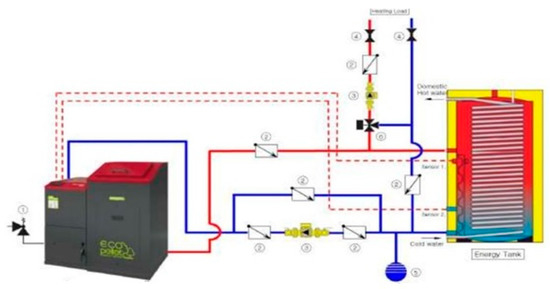
Figure 5.
Central heating system with biomass boiler.

Table 3.
Technical characteristics of biomass system.
4.2. Combined System with Biomass Boiler and Solar Thermal Collectors
As DHW energy needs can be covered with solar systems, especially in Mediterranean countries, this is a widely implemented application in residential buildings. The combination of a biomass boiler with a solar thermal system and the connection of the mechanical components are presented in Figure 6.
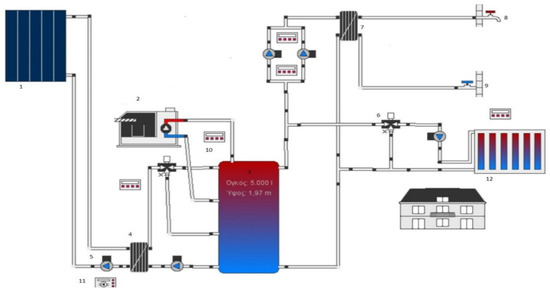
Figure 6.
Combined biomass–solar system.
The main parts of this system are the heat production system, namely the biomass boiler, the hot water storage tank, the piping system where the working medium flows, and all of the peripheral devices that regulate its operation, such as the circulators, the expansion tank, the heat exchangers, and the safety valves. The detailed technical characteristics of this system are presented in Table 4.

Table 4.
Technical characteristics of combined biomass–solar system.
4.3. Reference System Description
The aforementioned RES systems are compared to a conventional system that uses fossil fuel as an energy source. Considering that, it was decided that the reference system would be a central heating system for space heating and DHW production with an oil boiler. Its operating principle, as well as its infrastructure, is the same as the biomass boiler heating system. The only difference is the addition of an oil storage tank. The technical characteristics of the conventional boiler are presented in Table 5. The reference system is actually the conventional choice of the energy system with the use of an oil-fired boiler.

Table 5.
Technical characteristics of the reference system.
4.4. Heating System for Building with Enhanced Thermal Insulation
Within the framework of this paper, all of the aforementioned systems are studied both for a building that has the minimum thermal insulation specifications set by the national Greek Regulation on the Energy Performance of Buildings, and for a building with reinforced thermal insulation. Due to the additional thermal insulation, the building is expected to have lower heating requirements, both in terms of loads and consumption, and it is therefore necessary to reduce the capacity of the heating system. For example, the boilers should have lower nominal power, so that they operate as much as possible under full load conditions and, therefore, with higher efficiency. In addition, it should be noted that the reduction in the thermal loads also implies a reduction in the required solar collector surface in the combined solar thermal–biomass system. This is in order to identify the impact of insulation combined with the energy systems’ technologies in terms of energy efficiency and consumption, along with environmental impacts. To summarize, the detailed information for the infrastructure of each different scenario is presented in Table 6.

Table 6.
Technical characteristics of the systems studied based on insulation.
In conclusion, three basic energy scenarios are studied with regards to energy efficiency and environmental impacts: the first, the reference scenario with an oil boiler, is conventional, while the other two are renewable scenarios, i.e., one system supported only with a biomass boiler, and one scenario which is a combination of a biomass and a solar thermal system. All three energy systems are also studied using the minimum thermal insulation requirements defined by the national law, and also by implementing additional thermal insulation. The technical description of the systems is analyzed in detail in the previous tables, as it is important to realize the meaning of the connection and correlation of different mechanical components in order to ensure the operation and safety of the energy systems.
It is also important to present the building selected for the implementation of the above-mentioned energy systems. The studied building is a representative apartment building in Thessaloniki city in Greece. More specifically, it is a three-story building, with an additional ground floor, closed parking spaces, an underground floor, storage spaces, and a roof top. The building is considered as a representative construction typology, which is found in all of the country’s large urban centers, in terms of its size, materials, architecture, and construction details, as well as in terms of the distribution and layout of its spaces. In Table 7, the building’s surface analysis is presented.

Table 7.
Building’s surface analysis.
5. Energy Analysis of the Systems
The operational unit used in this analysis is defined as “twenty years of operation of the systems”, in order to calculate the total environmental load over the entire lifetime of the systems. Twenty years is the typical lifetime for heating systems [21,23]. In terms of system boundaries, it should be mentioned that the final disposal stage of the infrastructure is not taken into consideration. Thus, within the boundaries of the system are included the process of extracting raw materials, their transport to the processing units, the construction of the necessary equipment for each system, its transportation to the assembly site, and, finally, the twenty-year operation. Additionally, the corresponding processes for the production of the fuel and electricity consumed during operation are also included. The reason for not taking into account the final disposal stage is the long lifetime of the systems. In particular, heating systems have a lifespan of about twenty (20) years, which makes it difficult to predict final waste management technology that will be applied at that time, and, as a result, any assumption involves great uncertainty [22]. Regarding the geographical boundaries of the system, boilers for all systems are manufactured in Greece, while the same applies to the solar thermal collectors. Furthermore, the storage tank is manufactured in Greece, while the circulators are manufactured in Denmark. Moreover, the expansion tanks come from Germany. Finally, due to the fact that the origin of all raw materials was not known, authors considered that the production took place within Europe, and the required input data were collected from the Ecoinvent 3.7.1 database.
5.1. Energy Consumption
The total annual energy consumption for all the studied scenarios is summarized in Table 8.

Table 8.
Inventory of energy consumption for the energy systems studied.
5.2. Environmental Impact Assessment Results: Sensitivity Analysis Scenarios
5.2.1. Building with Minimum Insulation According to Regulations
The results for the reference, biomass, and solar biomass scenario are presented in Figure 7, for the midpoint analysis when the building is insulated according to the Greek national regulation. It is observed that the biomass system excels in ten of the total twenty-two categories (mainly in air particles and nitrogen oxide categories), a result which is related to the combustion in the operational phase, the land use, and the production and transport of fuel. The reference system excels in six impact categories, three of which concern global warming impacts due to operational emissions. Finally, the combined biomass–solar system excels in six categories, mainly in the ecotoxicity of the water and the extraction of mineral resources, which is due to the raw materials used for the construction of the solar thermal collectors. Regarding global warming, the heating system with the biomass boiler, and especially the energy system with the combination of biomass and solar energy, contributes less than 20% to the environmental impact related to climate change and GHG emissions, compared to the conventional oil boiler scenario (Figure 7).
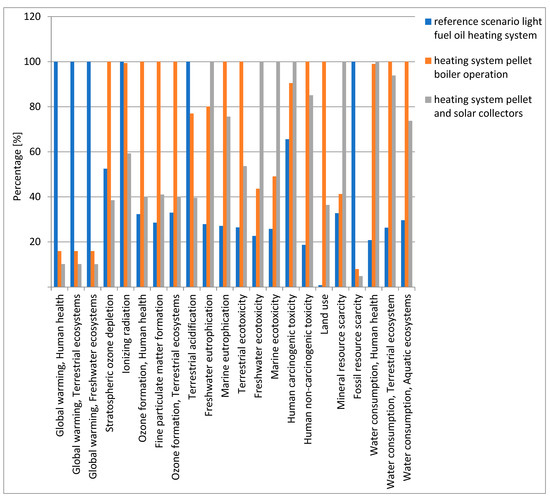
Figure 7.
Environmental impacts for building with minimum insulation according to KENAK.
Moreover, Figure 8 presents the calculated eco-points for each scenario for the endpoint analysis. Ecopoints are the normalized units for comparing the different environmental impacts, and reveal the general environmental profiles of the systems studied.
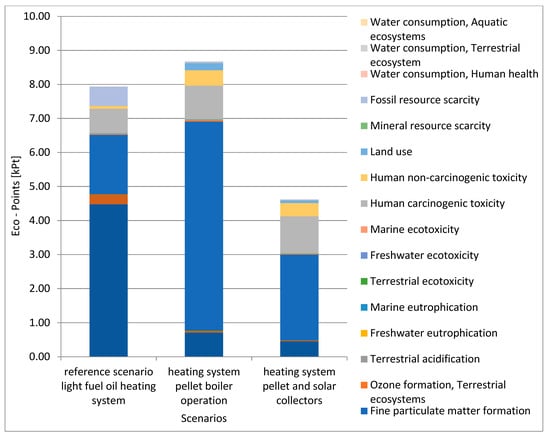
Figure 8.
Eco-points for building with minimum insulation according to KENAK.
It is observed that the biomass system has a higher environmental impact compared to the reference system, mainly due to the emissions of air particles as well as the production of toxic compounds. The construction of the equipment and the solid waste produced at the end of the combustion are responsible for the increased toxic compounds. Therefore, it is concluded that its overall operation is no more sustainable than fossil fuel systems. Overall, the difference between the two systems is 0.74 kPt. However, it should be mentioned that greenhouse gas emissions are reduced by 84% over the life cycle when the biomass system is used. The combined biomass–solar system has lower overall environmental impact, due to the reduction in gaseous pollutant emissions, as well as the reduction in the amount of used fuel. The reduction in the total environmental impact amounts to a percentage of approximately 43%. However, air particle emissions are high, which has a negative effect on the air quality in the urban environment. Furthermore, the required solar collector surface has a negative impact in the construction stage of the system.
Finally, and based on the endpoint analysis in Figure 9, the use of the pellet system is responsible for damages to human health compared to conventional and combined systems to solar systems. The ecosystem and source depletion are not affected significantly by the use of RES technologies. The endpoint analysis is important because it defines the way humans are affected by the environmental impacts of the systems. The combination of RES technologies is the one to achieve not only the energy efficiency targets, but also the reduced impacts to human health, resources, and the ecosystem. Analyzing the rather disappointing result in connection with the pellet boiler and human health is based on fine particle (PM2.5) mass concentration, which is increased because of the wood smoke emissions. More specifically, a 30% increase in PM2.5 mass concentration, as well as a 2–5-fold increase in the concentration of wood smoke tracers, including potassium, levoglucosan, mannosan, and galactosan, can be emitted into the air because of pellet boilers, and increase the human health impact [40].
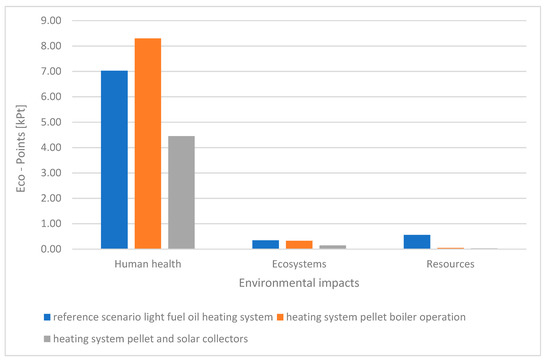
Figure 9.
Endpoint analysis for building with minimum insulation according to KENAK.
The result validation is implemented in a two-scale analysis, the first referring to the midpoint analysis, and the second regarding the endpoint analysis. Regarding the midpoint analysis, the validation of the results proved that, at the operation phase, the energy systems based on biomass technologies account for 83.16% of total nitrogen oxide emissions and 86.33% of PM 2.5 particulate matter emissions compared to the conventional one. Both Moretti et al. [24] and Ghafghazi et al. [19] concluded a similar result. They also referred to about 65% soil pollution, and more than 65% of ecotoxic compounds, something that is also validated with the current study. The construction stage contributes to the environmental impact at about 70%, basically because of mineral resource extraction (70.09%), something that is also confirmed by Monteleone et al. [41]. Furthermore, the percentage of contribution to the environmental impact concerning the carcinogenic compounds reached more than 85%, a percentage also confirmed by other similar LCA studies [19,41].
Moreover, at the endpoint analysis results, eco-points are used as normalization units in several LCA studies in order to cluster the environmental impact to three main categories: human health, natural resource depletion, and damage to the ecosystem [24,41]. It is observed that, in the life cycle of the biomass system, the human health sector amounts to 8.30 kPt, a value which corresponds with up to 95.73% of the total environmental load. Damage to the ecosystem amounts to 0.33 kPt, corresponding to about 4% of the total environmental effect, while the depletion of natural resources contributes an almost-negligible percentage to the total environmental impact of the system. These results were observed in the majority of studies relevant to biomass energy systems [19,23,41]. Finally, and in terms of validation, it is important to mention that results analysis is also connected not only to the processes included in the system studied, but also to the libraries and databases used for the impact assessment.
5.2.2. Sensitivity Analysis: Building with Enhanced Insulation
All three energy systems are also studied by implementing additional thermal insulation to the building’s envelope, according to the requirements for thermal insulation as foreseen by KENAK. Another set of scenarios compares the reference system and the RESs in a residential building with enhanced thermal insulation. The point is to identify the impact of additional insulation on the energy and environmental efficiency of RES technologies.
It is observed that the combined biomass–solar system is favored to a greater extent by the addition of thermal insulation (Figure 10). For example, in the category of soil acidification, its impact on human health is 27%, while in the scenario with minimum insulation, this percentage was 39%. This was expected, given that the simultaneous reduction in thermal loads and the small change in exploited solar energy led to lower fuel consumption and, therefore, to a greater reduction in emissions. However, the construction phase of the equipment, despite the reduction in impacts, is still particularly high. Finally, the calculated eco-points for each scenario for the endpoint analysis are presented in Figure 11.
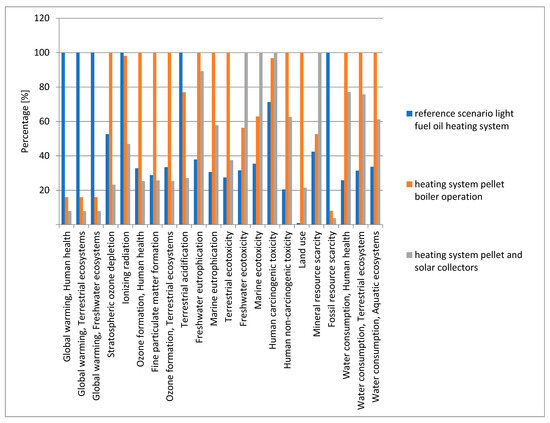
Figure 10.
Environmental impacts for building with additional insulation.
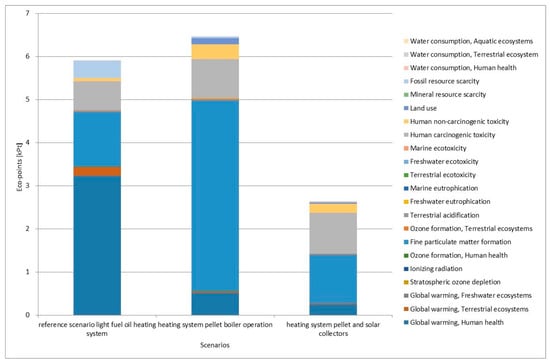
Figure 11.
Eco-points for building with additional insulation.
It is proven that the biomass system still has the greater environmental impact of the three systems considered. However, its difference compared to the reference system is reduced, from approximately 0.74 kPt for the building with minimum thermal insulation, to 0.56 kPt for the scenario with the additional thermal insulation. Thus, there was a 25% reduction in the calculated eco-points.
Therefore, reducing the energy demand of the building by adding thermal insulation is more beneficial for the biomass system. However, it is observed that the combined biomass–solar system also demonstrates a particularly significant reduction in the total environmental impact by about 1.88 kPt. However, the overall ranking of the systems has not changed. It is worth noting that, for the combined biomass–solar system, the environmental impact is lower and, at the same time, its construction is easier, due to the reduction in the infrastructure’s size.
6. Discussion and Future Research
Based on the analysis presented in the previous sections, carbon neutrality in the building sector is definitely not an easy task. It is a multicriteria issue that combines several parameters. First of all, there several sectors analyzed, including the built environment, energy and water supply, and transportation. Each sector has several criteria to determine in order to be evaluated in terms of efficiency and sustainability. In the decision-making process, the technical efficiency, the environmental impact, and the economic feasibility are issues to be defined. In all of these, the different parties involved make the tasks of resilience and carbon neutrality in cities even more difficult. Moreover, there are always the social criteria in the decision-making process of a city that is in total compliance with the expectations and quality of citizens’ lives. The habits and lifestyle of citizens can significantly increase the carbon footprint of a city. For instance, waste production, transportation, energy use, and goods consumption (food, clothes, furniture, materials, etc.), and other indirect emissions all contribute to the carbon footprint. The problem lies in the difficulty of controlling the indirect emissions. The citizens need motivation and increased awareness. The legislation framework, as well as the policies supported by standards, tools, and methodologies can lead the way to the combination of measures that can be taken in order to improve energy efficiency, reduce the energy used, and, therefore, reduce the environmental impact of sectors. The building sector is a sector which contributes significantly to a city’s energy demand, affecting, as we have observed, several environmental impacts of the building’s life cycle. The use phase, based on LCA, contributes about 80–90% to the environment compared to other stages of the building’s life cycle.
Furthermore, and in order to reach the vision of carbon neutrality, RES penetration is the major measure that can increase energy efficiency and reduce CO2 emissions. Based on the energy and environmental analysis of RES technologies focused on biomass and solar thermal systems, the biomass system demonstrated the most significant environmental impact compared to the conventional systems and the combined one with the solar thermal system’s contribution.
Finally, future research will focus on the economic effectiveness of the systems studied. Economic indicator evaluation, such as Net Present Value and Life Cycle Costing, provides a holistic economic analysis of the energy investment, taking into consideration the capital cost, the operational cost, and the maintenance cost of the system studied. The economic effectiveness of the energy system will complete the analysis in correlation to the environmental and technical evaluation results.
7. Conclusions
It is observed that the combined biomass–solar system demonstrated a significant reduction in the total environmental impact. Moreover, and taking into consideration the design phase and the technical feasibility of the study, it is worth noting that, for the combined biomass–solar system, the environmental impact is lower and, at the same time, its construction is easier, due to the reduction in the infrastructure’s size. It is also observed that the combined biomass–solar system is favored to a greater extent by the addition of thermal insulation. For example, in the category of soil acidification, its impact on human health is 27%, while in the scenario with the minimum insulation, this percentage was 39%. This was expected, given that the simultaneous reduction in thermal loads and the small change in exploited solar energy led to lower fuel consumption, and, therefore, to a greater reduction in emissions.
However, the construction phase of the equipment, despite the reduction in its impacts, is still particularly high. However, its difference compared to the reference system is reduced, from approximately 0.74 kPt for the building with minimum thermal insulation, to 0.56 kPt for the scenario with the additional thermal insulation. Thus, there was a 25% reduction in the calculated eco-points. Therefore, reducing the energy demand of the building by adding thermal insulation is more beneficial for the biomass system.
It is proven that the biomass system still has the greater environmental impact of the three systems considered, including the conventional one, especially in relation to PM emissions. However, its difference compared to the reference system is reduced, from approximately 0.74 kPt for the building with minimum thermal insulation, to 0.56 kPt for the scenario with the additional thermal insulation. Thus, there was a 25% reduction in the calculated eco-points, which is a clearly noticed percentage of improvement.
Therefore, reducing the energy demand of the building by adding thermal insulation is more beneficial for the biomass system. However, it is observed that the combined biomass–solar system also demonstrates a particularly significant reduction in the total environmental impact, by about 1.88 kPt. However, the overall ranking of the systems has not changed. It is worth noting that for the combined biomass–solar system, the environmental impact is lower and, at the same time, its construction is easier, due to the reduction in the infrastructure’s size.
In conclusion, one can claim that sustainability, as well as resilience in the building sector, is a challenge in terms of energy efficiency and low carbon emission goals. RESs are among the top priority measures in accomplishing the target of decarbonization in buildings. Nevertheless, the choice of the type of RES is not a one-dimensional problem, and the optimal combination may not be unique. Last but not least, and as a thought for further analysis in the future, the cost effectiveness of the RES technologies compared to conventional systems would be interesting and crucial for the application of RESs. Cost effectiveness is a key issue for energy investments and should be evaluated in terms of the integrated analysis of energy solutions in the building sector.
Author Contributions
Conceptualization, E.G.; methodology, E.G., A.P. (Athanasios Papaevaggelou); validation, E.G. and E.K.; data curation, E.G. and E.K.; writing—original draft preparation, E.G. and E.K.; writing—review and editing, E.G. and E.K.; supervision, A.P. (Agis Papadopoulos). All authors have read and agreed to the published version of the manuscript.
Funding
This research received no external funding.
Data Availability Statement
Not applicable.
Conflicts of Interest
The authors declare no conflict of interest.
Nomenclature
| RES | Renewable Energy Systems |
| LCA | Life Cycle Analysis |
| LCEA | Life Cycle Energy Analysis |
| LCIA | Life Cycle Impact Assessment |
| DHW | Domestic Hot Water |
| KENAK | Greek Regulation on the Energy Performance of Buildings |
References
- Available online: https://ec.europa.eu/clima/policies/strategies/2020_en (accessed on 24 March 2023).
- Available online: https://ec.europa.eu/clima/policies/strategies/2030_en (accessed on 24 March 2023).
- Available online: https://ec.europa.eu/clima/policies/strategies/2050_en (accessed on 24 March 2023).
- Giama, E.; Kyriaki, E.; Fokaides, P.; Papadopoulos, A.M. Energy policy towards nZEB: The Hellenic and Cypriot case. Energy Sources Part A Recovery Util. Environ. Eff. 2021, 1–14. [Google Scholar] [CrossRef]
- European Environment Agency. Trends and Projections in Europe 2022; ΕΕA Report No 10/2022; Publications Office of the European Union: Brussels, Belgium, 2022. [Google Scholar] [CrossRef]
- IPCC, Intergovernmental Panel for Climate Change. Climate Change 2021. The Physical Science Basis. Summary for Policymakers; IPCC: Geneva, Switzerland, 2021. [Google Scholar]
- United Nations Economic Commission for Europe (UNECE). In Proceedings of the International Conference on Raising Awareness on Adaptation on Transport Infrastructure to Climate Change Impacts, Athens, Greece, 18–19 November 2019; Available online: https://unece.org/international-conference-raising-awareness-adaptation-transport-infrastructure-climate-change (accessed on 26 March 2023).
- Eurostat. How Are Emissions of Greenhouse Gases in the EU Evolving; Eurostat: Luxembourg, 2020. [Google Scholar]
- European Comission. Directive 2009/28/EC of the European Parliament and of the Council; European Union: Bruxelles, Belgium, 2008. [Google Scholar]
- EU Strategy Green Deal. Available online: https://ec.europa.eu/info/energy-climate-change-environment/overall-targets-and-reporting/2050-targets_en (accessed on 26 March 2023).
- Milousi, M.; Souliotis, M. A circular economy approach to residential solar thermal systems. Renew. Energy 2023, 207, 242–252. [Google Scholar] [CrossRef]
- Kyriaki, E.; Giama, E.; Papadopoulou, A.; Drosou, V.; Papadopoulos, A.M. Energy and Environmental Performance of Solar Thermal Systems in Hotel Buildings. Procedia Environ. Sci. 2017, 38, 36–43. [Google Scholar] [CrossRef]
- Papadopoulos, A.M. Active Solar Heating and Cooling of Buildings. In Solar Thermal Technologies for buildings, The state of the art, Santamouris, M., Ed.; Routledge: London UK, 2003; pp. 17–35. [Google Scholar] [CrossRef]
- Mishra, S.; Kharkar, P.S.; Pethe, A.M. Biomass and waste materials as potential sources of nanocrystalline cellulose: Comparative review of preparation methods (2016–Till date). Carbohydr. Polym. 2019, 207, 418–427. [Google Scholar] [CrossRef]
- Available online: https://1gymanatolis-energeia.weebly.com/betaiotaomicronmu940zetaalpha.html (accessed on 24 March 2023).
- Thirugnanasambandam, M.; Iniyan, S.; Goic, R. A review of solar thermal technologies. Renew. Sustain. Energy Rev. 2010, 14, 312–322. [Google Scholar] [CrossRef]
- Lin, H.; Clavreul, J.; Jeandaux, C.; Crawley, J.; Butnar, I. Environmental life cycle assessment of heating systems in the UK: Comparative assessment of hybrid heat pumps vs. condensing gas boilers. Energy Build. 2021, 240, 110865. [Google Scholar] [CrossRef]
- Scharrer, D.; Eppinger, B.; Schmitt, P.; Zenk, J.; Bazan, P.; Karl, J.; German, R. Life cycle assessment of a reversible heat pump–organic rankine cycle–heat storage system with geothermal heat supply. Energies 2020, 13, 3253. [Google Scholar] [CrossRef]
- Ghafghazi, S.; Sowlati, T.; Sokhansanj, S.; Bi, X.; Melin, S. Life cycle assessment of base–load heat sources for district heating system options. Int. J. Life Cycle Assess. 2011, 16, 212–223. [Google Scholar] [CrossRef]
- Monteleone, M.; Chiesa, M.; Marzuoli, R.; Verma, V.K.; Schwarz, M.; Carlon, E.; Schmidl, C.; Denti, A.B. Life cycle analysis of small scale pellet boilers characterized by high efficiency and low emissions. Appl. Energy 2015, 155, 160–170. [Google Scholar] [CrossRef]
- Grygierek, K.; Ferdyn-Grygierek, J. Analysis of the Environmental Impact in the Life Cycle of a Single-Family House in Poland. Atmosphere 2022, 13, 245. [Google Scholar] [CrossRef]
- Neri, E.; Cespi, D.; Setti, L.; Gombi, E.; Bernardi, E.; Vassura, I.; Passarini, F. Biomass residues to renewable energy: A life cycle perspective applied at a local scale. Energies 2016, 9, 922. [Google Scholar] [CrossRef]
- Miralles, J.A.L.; García, R.L.; Carnicero, J.M.P.; Martínez, F.J.R. Comparative study of heat pump system and biomass boiler system to a tertiary building using the Life Cycle Assessment (LCA). Renew. Energy 2020, 152, 1439–1450. [Google Scholar] [CrossRef]
- Moretti, E.; Barbanera, M.; Foschini, D.; Buratti, C.; Cotana, F. Energy and Environmental Performance Analysis of Biomass-fuelled Combined Cooling and Heating System for Commercial Building Retrofit: An Italian Case Study. Energy Procedia 2016, 101, 376–383. [Google Scholar] [CrossRef]
- Košičan, J.; Pardo Picazo, M.Á.; Vilčeková, S.; Košičanová, D. Life cycle assessment and economic energy efficiency of a solar thermal installation in a family house. Sustainability 2021, 13, 2305. [Google Scholar] [CrossRef]
- Feofilovs, M.; Pakere, I.; Romagnoli, F. Life cycle assessment of different low-temperature district heating development scenarios: A case study of municipality in Latvia. Environ. Clim. Technol. 2019, 23, 272–290. [Google Scholar] [CrossRef]
- Resch, E.; Andresen, I. Database Tool for Systematic Analysis of Embodied Emissions in Buildings and Neighborhoods. Buildings 2018, 8, 106. [Google Scholar] [CrossRef]
- Akbarnezhad, A.; Jianzhuang, X. Estimation and Minimization of Embodied Carbon of Buildings: A Review. Buildings 2017, 7, 5. [Google Scholar] [CrossRef]
- Kiehbadroudinezhad, M.; Merabet, A.; Hosseinzadeh-Bandbafha, H. A life cycle assessment perspective on biodiesel production from fish wastes. Bioresour. Technol. Rep. 2023, 21, 101303. [Google Scholar] [CrossRef]
- Lü, X.; Lu, T.; Karirinne, S.; Mäkiranta, A.; Clements-Croome, D. Renewable energy resources and multi-energy hybrid systems for urban buildings in Nordic climate for green microgrids in a circular bioeconomy. Energy Build. 2023, 282, 112789. [Google Scholar] [CrossRef]
- Abrahamsen, F.E.; Ruud, S.G.; Gebremedhin, A. Assessing Efficiency and Environmental Performance of a Nearly Zero-Energy University Building’s Energy System in Norway. Buildings 2023, 13, 169. [Google Scholar] [CrossRef]
- Hou, Y.; Yang, B.; Zhang, S.; Qi, Y.; Yu, X. 4E analysis of an integrated solar-biomass heating system: A case study in rural housing of northern China. Sustain. Energy Technol. Assess. 2022, 53, 102794. [Google Scholar] [CrossRef]
- Liang, J.; Irfan, M.; Ikram, M.; Zimon, D. Evaluating natural resources volatility in an emerging economy: The influence of solar energy development barriers. Resour. Policy 2022, 78, 102858. [Google Scholar] [CrossRef]
- Zimon, D.; Wozniak, J.; Domingues, P.; Ikram, M.; Kuś, H. Proposition of Improving Selected Logistics Processes of Pellet Production. Int. J. Qual. Res. 2014, 15, 387–402. [Google Scholar] [CrossRef]
- Giama, E. Review on Ventilation Systems for Building Applications in Terms of Energy Efficiency and Environmental Impact Assessment. J. Energ. 2022, 15, 98. [Google Scholar] [CrossRef]
- Giama, E.; Chantzis, G.; Kontos, S.; Keppas, S.; Poupkou, A.; Liora, N.; Melas, D. Building Energy Simulations Based on Weather Forecast Meteorological Model: The Case of an Institutional Building in Greece. J. Energ. 2023, 16, 191. [Google Scholar] [CrossRef]
- Joint Research Centre, European Commission. International Reference Life Cycle Data System (ILCD) Handbook: General Guide for Life Cycle Assessment—Detailed Guidance; Institute for Environment and Sustainability: Luxembourg, 2010. [Google Scholar]
- Benini, L.; Mancini, L.; Sala, S.; Manfredi, S.; Schau, E.; Pant, R. Normalisation Method and Data for Environmental Footprints, EUR 26842; Publications Office of the European Union: Luxembourg, 2014; JRC91531; Available online: https://publications.jrc.ec.europa.eu/repository/handle/JRC91531 (accessed on 28 March 2023).
- Sima Pro; Simulation tool; PRé Sustainability: Amersfoort, The Netherlands. Available online: https://simapro.com/ (accessed on 26 March 2023).
- Saffari, A.; Daher, N.; Samara, C.; Voutsa, D.; Kouras, A.; Manoli, E.; Karagkiozidou, O.; Vlachokostas Ch Moussiopoulos, N.; Shafer, M.M.; Schauer, J.J.; et al. Increased biomass burning due to the economic crisis in Greece and its adverse impact on wintertime air quality in Thessaloniki. Environ. Sci. Technol. 2013, 47, 13313–13320. [Google Scholar] [CrossRef]
- Basosi, R.; Bonciani, R.; Frosali, D.; Manfrida, G.; Parisi, M.L.; Sansone, F. Life cycle analysis of a geothermal power plant: Comparison of the environmental performance with other renewable energy systems. Sustainability 2020, 12, 2786. [Google Scholar] [CrossRef]
Disclaimer/Publisher’s Note: The statements, opinions and data contained in all publications are solely those of the individual author(s) and contributor(s) and not of MDPI and/or the editor(s). MDPI and/or the editor(s) disclaim responsibility for any injury to people or property resulting from any ideas, methods, instructions or products referred to in the content. |
© 2023 by the authors. Licensee MDPI, Basel, Switzerland. This article is an open access article distributed under the terms and conditions of the Creative Commons Attribution (CC BY) license (https://creativecommons.org/licenses/by/4.0/).